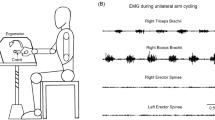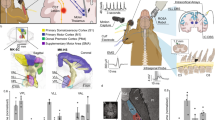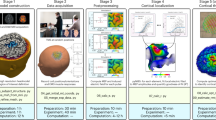Abstract
Study design:
A cross-sectional study in chronic spinal cord injury with cervical lesions (cSCI).
Objective:
To determine the corticomotor projection and motor cortex organization of paralyzed forearm muscles that presented only liminal voluntary activation.
Setting:
Burke Medical Research Institute, White Plains, NY, USA.
Methods:
We identified ten people with chronic SCI who had a wrist flexor or extensor muscle with a motor power (MP) of 1 over 5. We recorded motor evoked potentials (MEPs) to transcranial magnetic stimulation (TMS) over the primary motor cortex of the hemisphere contralateral to the target muscle. We measured resting motor threshold (RMT), corticomotor latency (LTY), MEP amplitude (AMP) and performed cortical motor mapping to determine the optimal site (OPT) and map area (AREA). Results were compared with the data from 18 controls.
Results:
A MEP in the target muscle was observed for all cSCI cases. LTY was normal, while corticomotor excitability (as determined by RMT and AMP) was reduced in about half of the group. The OPT site of the motor maps was within control range for all cSCI cases, while AREA was reduced in three cases.
Conclusions:
Corticomotor conduction and cortical topography were appreciably normal despite only liminal activation of the target muscle with voluntary effort. Muscles with these characteristics may benefit from a targeted rehabilitation program even in the chronic phase after SCI.
Similar content being viewed by others
Log in or create a free account to read this content
Gain free access to this article, as well as selected content from this journal and more on nature.com
or
References
Welch RD, Lobley SJ, O'Sullivan SB, Freed MM . Functional independence in quadriplegia: critical levels. Arch Phys Med Rehabil 1986; 67: 235–240.
Ditunno JF Jr, Sipski ML, Posuniak EA, Chen YT, Staas WE Jr, Herbison GJ . Wrist extensor recovery in traumatic quadriplegia. Arch Phys Med Rehabil 1987; 68 (5 Pt 1): 287–290.
Hanson RW, Franklin MR . Sexual loss in relation to other functional losses for spinal cord injured males. Arch Phys Med Rehabil 1976; 57: 291–293.
Edwards DJ, Cortes M, Thickbroom GW, Rykman A, Pascual-Leone A, Volpe BT . Preserved corticospinal conduction without voluntary movement after spinal cord injury. Spinal Cord 2013; 51: 765–767.
Curt A, Dietz V . Electrophysiological recordings in patients with spinal cord injury: significance for predicting outcome. Spinal Cord 1999; 37: 157–165.
Iseli E, Cavigelli A, Dietz V, Curt A . Prognosis and recovery in ischaemic and traumatic spinal cord injury: clinical and electrophysiological evaluation. J Neurol Neurosurg Psychiatry 1999; 67: 567–571.
Jurkiewicz MT, Crawley AP, Verrier MC, Fehlings MG, Mikulis DJ . Somatosensory cortical atrophy after spinal cord injury: a voxel-based morphometry study. Neurology 2006; 66: 762–764.
Nie B, Chen K, Zhao S, Liu J, Gu X, Yao Q et al. A rat brain MRI template with digital stereotaxic atlas of fine anatomical delineations in paxinosspace and its automated application in voxel-wise analysis. Hum Brain Mapp 2013; 34: 1306–1318.
Ghosh A, Haiss F, Sydekum E, Schneider R, Gullo M, Wyss MT et al. Rewiring of hindlimb corticospinal neurons after spinal cord injury. Nat Neurosci. 2010; 13: 97–104.
Lotze M, Laubis-Herrmann U, Topka H . Combination of TMS and fMRI reveals a specific pattern of reorganization in M1 in patients after complete spinal cord injury. Restor Neurol Neurosci 2006; 24: 97–107.
Kokotilo KJ, Eng JJ, Curt A . Reorganization and preservation of motor control of the brain in spinal cord injury: a systematic review. J Neurotrauma 2009; 26: 2113–2126.
Wilson SA, Thickbroom GW, Mastaglia FL . Transcranial magnetic stimulation mapping of the motor cortex in normal subjects. the representation of two intrinsic hand muscles. J Neurol Sci 1993; 118: 134–144.
Freund P, Rothwell J, Craggs M, Thompson AJ, Bestmann S . Corticomotor representation to a human forearm muscle changes following cervical spinal cord injury. Eur J Neurosci 2011; 34: 1839–1846.
Thickbroom GW, Byrnes ML, Mastaglia FL . Methodology and application of TMS mapping. Electroencephalogr Clin Neurophysiol Suppl 1999; 51: 48–54.
Brasil-Neto JP, Cohen LG, Panizza M, Nilsson J, Roth BJ, Hallett M . Optimal focal transcranial magnetic activation of the human motor cortex: effects of coil orientation, shape of the induced current pulse, and stimulus intensity. J Clin Neurophysiol 1992; 9: 132–136.
Rossi S, Hallett M, Rossini PM, Pascual-Leone A, Safety of TMS Consensus Group. Safety, ethical considerations, and application guidelines for the use of transcranial magnetic stimulation in clinical practice and research. Clin Neurophysiol 2009; 120: 2008–2039.
Rothwell JC, Hallett M, Berardelli A, Eisen A, Rossini P, Paulus W . Magnetic stimulation: motor evoked potentials. The International Federation of Clinical Neurophysiology. Electroencephalogr Clin Neurophysiol Suppl 1999; 52: 97–103.
Edwards DJ, Cortes M, Thickbroom GW, Rykman A, Pascual-Leone A, Volpe BT . Reply: evidence against volume conduction to explain normal MEPs in muscles with low motor power in SCI. Spinal Cord 2014; 52: 718.
Calancie B, Alexeeva N, Broton JG, Suys S, Hall A, Klose KJ . Distribution and latency of muscle responses to transcranial magnetic stimulation of motor cortex after spinal cord injury in humans. J Neurotrauma 1999; 16: 49–67.
Li K, Atkinson D, Boakye M, Tolfo CZ, Aslan S, Green M et al. Quantitative and sensitive assessment of neurophysiological status after human spinal cord injury. J Neurosurg Spine 2012; 17: 77–86.
Awad BI, Carmody MA, Zhang X, Lin VW, Steinmetz MP . Transcranial magnetic stimulation after spinal cord injury. World Neurosurg 2015; 83: 232–235.
Chye L, Nosaka K, Murray L, Edwards D, Thickbroom G . Corticomotor excitability of wrist flexor and extensor muscles during active and passive movement. Hum Mov Sci 2010; 29: 494–501.
Steeves JD, Lammertse D, Curt A, Fawcett JW, Tuszynski MH, Ditunno JF et al. International Campaign for Cures of Spinal Cord Injury Paralysis. Guidelines for the conduct of clinical trials for spinal cord injury (SCI) as developed by the ICCP panel: clinical trial outcome measures. Spinal Cord 2007; 45: 206–221.
Bunge RP, Puckett WR, Hiester ED . Observations on the pathology of several types of human spinal cord injury, with emphasis on the astrocyte response to penetrating injuries. Adv Neurol 1997; 72: 305–315.
Kakulas BA . Neuropathology: the foundation for new treatments in spinal cord injury. Spinal Cord 2004; 42: 549–563.
Tansey KE, McKay WB, Kakulas BA . Restorative neurology: consideration of the new anatomy and physiology of the injured nervous system. Clin Neurol Neurosurg 2012; 114: 436–440.
Hou J, Xiang Z, Yan R, Zhao M, Wu Y, Zhong J et al. Motor recovery at 6 months after admission is related to structural and functional reorganization of the spine and brain in patients with spinal cord injury. Hum Brain Mapp 2016; 37: 2195–2209.
Sydekum E, Ghosh A, Gullo M, Baltes C, Schwab M, Rudin M . Rapid functional reorganization of the forelimb cortical representation after thoracic spinal cord injury in adult rats. Neuroimage 2014; 87: 72–79.
Tandon S, Kambi N, Mohammed H, Jain N, . Complete reorganization of the motor cortex of adult rats following long-term spinal cord injuries. Eur J Neurosci 2013; 38: 2271–2279.
Author information
Authors and Affiliations
Corresponding author
Ethics declarations
Competing interests
The authors declare no conflict of interest.
Additional information
Data archiving
There were no data to deposit.
Rights and permissions
About this article
Cite this article
Cortes, M., Thickbroom, G., Elder, J. et al. The corticomotor projection to liminally-contractable forearm muscles in chronic spinal cord injury: a transcranial magnetic stimulation study. Spinal Cord 55, 362–366 (2017). https://doi.org/10.1038/sc.2016.161
Received:
Revised:
Accepted:
Published:
Issue date:
DOI: https://doi.org/10.1038/sc.2016.161
This article is cited by
-
Corticospinal Motor Circuit Plasticity After Spinal Cord Injury: Harnessing Neuroplasticity to Improve Functional Outcomes
Molecular Neurobiology (2021)
-
Understanding cortical topographical changes in liminally contractable muscles in SCI: importance of all mechanisms of neural dysfunction
Spinal Cord (2017)



